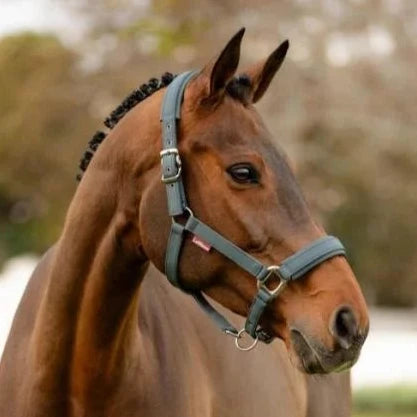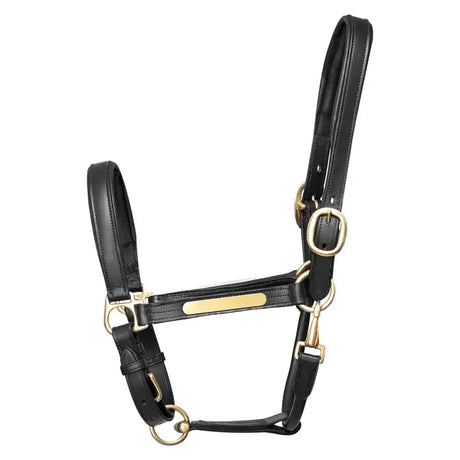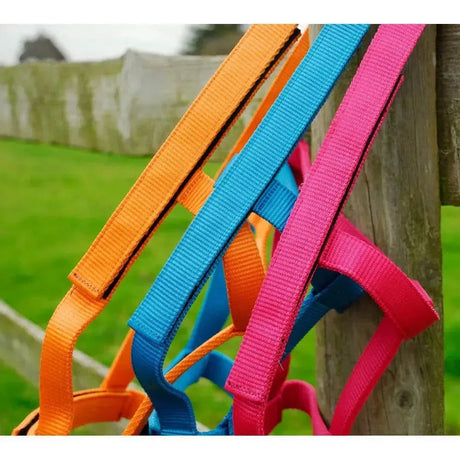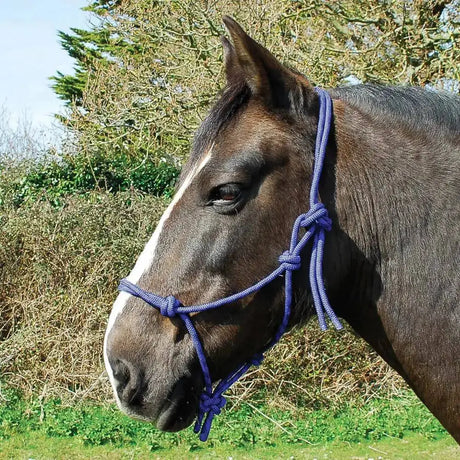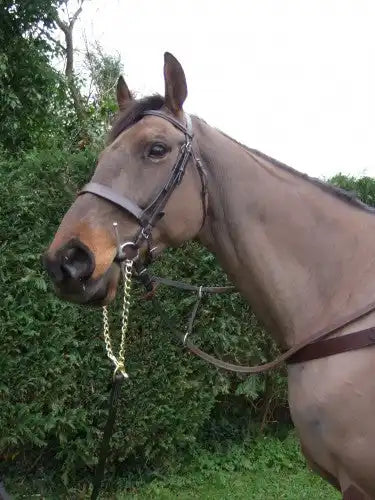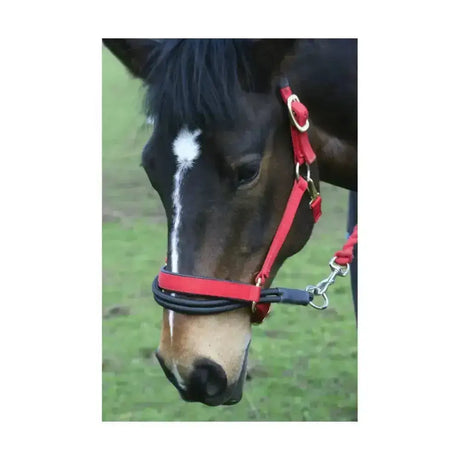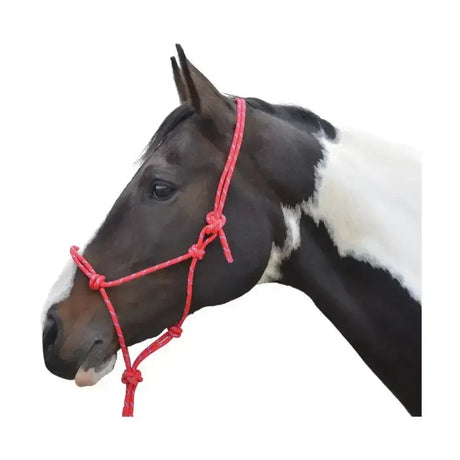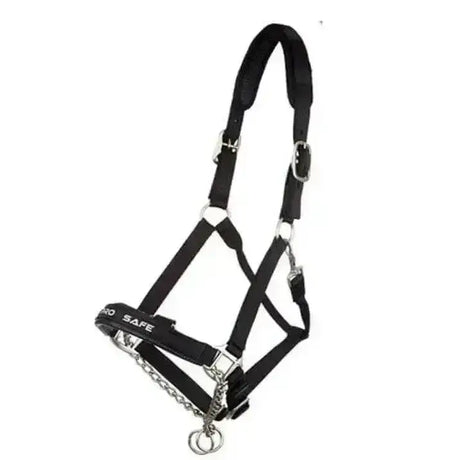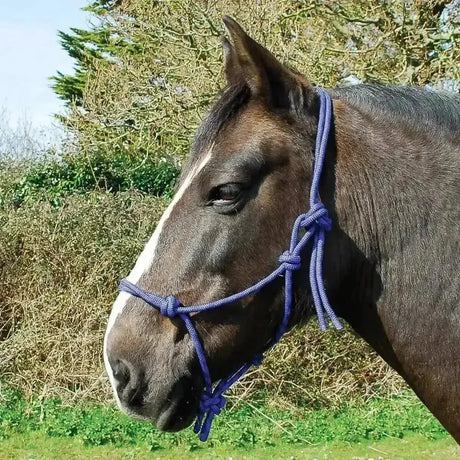Control Headcollars
Control headcollars, also known as training headcollars, pressure halters, or discipline halters, are designed to provide additional control over a horse, particularly during handling, training, or in situations where the horse may be prone to pulling, rearing, or being difficult to manage. These headcollars work by applying pressure to specific areas of the horse’s head, encouraging compliance without the need for excessive force.
Key Features of Control Headcollars:
-
Pressure-Activated Design:
- Control headcollars are engineered to apply pressure to key points on the horse's face—primarily the nose, poll, and chin—when the horse pulls or resists. When the horse relaxes or responds to the handler’s commands, the pressure is released, reinforcing positive behavior.
- This pressure-and-release mechanism is central to the design, helping horses learn to yield to light cues, improving responsiveness over time.
-
Material:
- Control headcollars are typically made from durable materials such as nylon, leather, or synthetic webbing, which are strong enough to handle the additional forces exerted during training. Some may also include padded areas for added comfort where the pressure is applied.
- Some control headcollars may include metal hardware or reinforced rings for attaching lead ropes or lunge lines, providing additional durability.
-
Types of Control Headcollars:
-
Pressure Halters: Similar to rope halters but with added pressure points or knots in specific areas to increase the effectiveness of pressure-and-release training. These halters are often used in groundwork and leading exercises.
-
Poll Control Headcollars: These headcollars apply pressure on the poll (the area behind the ears) when the horse pulls or resists, encouraging the horse to lower its head and relax. This type is useful for horses that tend to throw their heads up or resist bridling.
-
Combination Headcollars: Some control headcollars combine nose and poll pressure for more comprehensive control. These are often adjustable and can be used for horses that are difficult to manage in stressful situations or during training.
-
Martingale Headcollars: These headcollars come with additional straps (martingales) that connect to the lead rope or reins, applying pressure not only on the nose and poll but also under the chin, preventing the horse from raising its head too high or pulling.
-
Adjustability:
- Most control headcollars feature adjustable straps for a custom fit, ensuring the halter applies pressure in the correct areas without causing discomfort. The fit is crucial to ensuring the headcollar works as intended without causing undue stress or pain.
-
Benefits of Control Headcollars:
-
Improved Handling: Control headcollars are especially useful for horses that are difficult to lead, tend to pull, or show strong reactions during handling. The strategic application of pressure helps curb undesirable behaviors by encouraging the horse to yield and cooperate.
-
Safe Training Tool: When used correctly, these headcollars provide a humane and effective way to communicate with the horse without resorting to force. The pressure applied is firm but not painful, with the design relying on the horse learning to respond to pressure and release cues.
-
Enhances Responsiveness: The headcollar’s design encourages horses to become more responsive to light commands, reducing the need for the handler to pull or use excessive force.
-
Versatility: Control headcollars can be used for a wide range of activities, from basic groundwork and desensitization to lunging, leading, and even trailer loading. Their versatility makes them a valuable tool for both novice and experienced horse handlers.
-
Popular Situations for Using Control Headcollars:
-
Groundwork Training: Control headcollars are excellent for groundwork, where precision and clear communication are essential. The pressure mechanism teaches horses to respond to commands like "whoa," "stand," or "yield" with minimal force.
-
Leading Difficult Horses: Horses that pull, rear, or refuse to move forward can be more easily managed with a control headcollar. The added pressure discourages pulling or other unwanted behaviors.
-
Loading into Trailers: For horses that are nervous or resistant to loading, control headcollars provide additional leverage and control, making the process safer and more efficient for both horse and handler.
-
Desensitization and Handling: Horses that are nervous or unhandled benefit from the clear, direct communication provided by a control headcollar, making it easier to introduce new stimuli and encourage calm behavior.
-
Considerations When Using Control Headcollars:
-
Correct Use is Essential: Control headcollars can be very effective, but improper use can lead to discomfort or even injury. Handlers should avoid using excessive force or constant pressure, as this can cause the horse to become tense or resistant.
-
Proper Fit: The headcollar must be fitted correctly to ensure that pressure is applied in the right areas without causing pain. The noseband should sit above the sensitive nasal bone and not too low, while the poll strap should be snug but not overly tight.
-
Training with Supervision: For best results, especially with more sensitive or reactive horses, it's advisable to use control headcollars under the guidance of an experienced trainer or equine professional.
-
Popular Brands for Control Headcollars:
-
Dually Headcollar by Monty Roberts: This well-known headcollar is a favorite in the natural horsemanship community, featuring a dual-action system that allows the handler to control the horse with both nose and poll pressure. It's adjustable and can be used in multiple training scenarios.
-
Parelli Natural Horsemanship Rope Halters: Parelli halters offer a combination of a lightweight rope design with strategic knot placements for pressure, making them popular for groundwork and groundwork training.
-
Shires Control Headcollars: Shires offers a range of control headcollars that feature adjustable straps and durable materials. These headcollars are designed to give handlers more control during difficult situations without compromising comfort.
-
Mark Todd Control Headcollar: This brand is known for producing high-quality equestrian products, including control headcollars that are designed for both schooling and handling difficult horses. They combine comfort and control, often with padded nosebands.
-
How to Choose the Right Control Headcollar:
-
Behavioral Needs: Consider your horse’s specific behavioral challenges. If your horse pulls on the lead or raises its head frequently, a poll control headcollar might be the best choice. If your horse needs more overall control during groundwork, a pressure halter with nose and poll pressure may be more effective.
-
Material and Durability: Look for a headcollar made from durable materials like nylon or leather, especially if you’ll be using it regularly for training. Check that all hardware, such as rings or buckles, is strong and rust-resistant.
-
Fit and Adjustability: Ensure the headcollar is adjustable so that you can fit it to your horse’s specific size and shape. A proper fit ensures effectiveness and comfort.
-
Comfort: Some control headcollars come with padded sections to reduce the risk of chafing or irritation. If your horse has sensitive skin or if you plan to use the headcollar for extended periods, look for options with padding.
Tips for Using Control Headcollars Effectively:
-
Apply Pressure Gently: Always start with light pressure and increase it only if necessary. The goal is for the horse to respond to minimal cues.
-
Release Quickly: As soon as the horse responds to the pressure, release it immediately. This teaches the horse that yielding to pressure is rewarded with comfort.
-
Be Consistent: Consistency in your handling and training helps the horse understand what is expected. Use the headcollar regularly during training sessions to reinforce good behavior.
Control headcollars are a valuable tool for improving communication between horse and handler.


